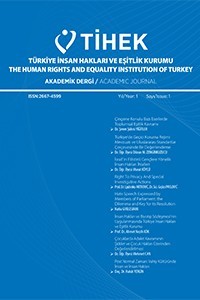ÇOCUK HAKLARI PERSPEKTİFİNDEN ORMAN OKULU EĞİTİMİNİN ÖNEMİ
Orman okulu eğitimi, öğrencilere doğada sürükleyici öğrenme deneyimleri sunarak sosyal, duygusal ve bilişsel gelişimlerine katkıda bulunan bir eğitim modelidir. Bu makale, çocuk hakları ve sağladığı faydalar açısından orman okulu eğitiminin önemini incelemeyi amaçlamaktadır. Araştırmalar, orman okulu eğitiminin çocukların fiziksel ve zihinsel sağlığına, özgüvenine ve sorumluluk duygusuna olumlu etkileri olduğunu göstermektedir. Ayrıca, orman okulu eğitimi, çocukların doğayla bağlantı kurmalarına ve çevre bilincini geliştirmelerine destek olmaktadır. Sonuç olarak, orman okulu eğitimi sayesinde çocuklar daha sağlıklı, özgüvenli ve sorumlu bireyler haline gelmektedir. Küresel çevresel sorunlarla mücadele etmeye devam ederken, çocukların doğayla ömür boyu bağlar kurmalarını ve güçlü bir çevre sorumluluğu bilinci geliştirmelerini teşvik eden orman okulu eğitimi gibi alternatif eğitim yaklaşımlarına öncelik verilmesi ve desteklenmesi önemlidir.
Anahtar Kelimeler:
Orman Okulu, Çocuk Hakları, Doğa Eğitimi, Fiziksel Sağlık, Zihinsel Sağlık, Sürdürülebilir Kalkınma
The Importance of Forest School Education from the Perspective of Children's Rights
Forest school education is an educational model that contributes to the social, emotional, and cognitive development of students by providing them with immersive learning experiences in nature. This article aims to examine the importance of forest school education in terms of children's rights and the benefits it provides. Research shows that forest school education has positive effects on children's physical and mental health, self-confidence, and sense of responsibility. Additionally, forest school education supports children in connecting with nature and developing environmental awareness. As a result, children grow up to be healthier, more self-confident, and responsible individuals. As we continue to grapple with global environmental challenges, it is crucial to prioritize and support alternative education approaches like forest school education that encourage children to form lifelong bonds with nature and develop a strong sense of environmental responsibility.
Keywords:
Forest School, Children, Nature Education, Physical Health, Mental Health, Sustainable Development,
___
- Bentsen, P., Jensen, F. S., & Mygind, E. (2009). The Nature of Children’s Outdoor Play: A Cross-Sectional Study of Children’s Outdoor Play Areas in Southern Denmark. Scandinavian Journal of Public Health, 37(4), 404-411.
- Brooker, L., Blaise, M., Edwards, S., & Sumsion, J. (2018). Theorising Outdoor Play in Early Childhood Education: Resisting the Discourse of Developmentally Appropriate Practice. Contemporary Issues in Early Childhood, 19(3), 230-245.
- Brown, K. (2015). Nature-Based Learning and Play for Young Children: A Guide to Outdoor Curriculum. New York: Routledge.
- Brown, N. (2015). Nature-Based Learning for Young Children: Anytime, Anywhere, on Any Budget. St. Paul, MN: Redleaf Press.
- Chawla, L. (2015). Children’s Rights and Forest School Education. International Journal of Early Childhood Environmental Education, 3(1), 50-58.
- Fjørtoft, I. (2004). Landscape as Playscape: The Effects of Natural Environments on Children’s Play and Motor Development. Children, Youth and Environments, 14(2), 21-44.
- Gill, T. (2014). The Benefits of Children’s Engagement with Nature: A Systematic Literature Review. Children, Youth and Environments, 24(2), 10-34.
- Grahn, P., et al. (1997). Landscape Planning and Stress. Urban Forestry & Urban Greening, 6(1), 49-58.
- Hanski, I., et al. (2012). Environmental Biodiversity, Human Microbiota, and Allergy Are Interrelated. Proceedings of the National Academy of Sciences, 109(21), 8334-8339.
- Jones, E. (2012). Forest School Education and Environmental Awareness. Early Child Development and Care, 182(1), 77-89.
- Jones, L. (2012). Forest School and Sustainable Development. London: Routledge.
- Jones, M. (2012). Forest School Education and Responsibility. International Journal of Early Years Education, 20(1), 77-89.
- Knight, S. (2013). Forest Schools and Outdoor Learning in the Early Years. London: SAGE Publications.
- Lieberman, G. A., & Hoody, L. L. (1998). Closing the Achievement Gap: Using the Environment as an Integrating Context for Learning. State Education and Environment Roundtable.
- Louv, R. (2008). Last Child in the Woods: Saving Our Children from Nature-Deficit Disorder. Algonquin Books.
- O’Brien, L. (2009). Children’s Outdoor Play & Learning Environments: Returning to Nature. Routledge.
- O’Brien, L., & Murray, R. (2007). Forest School and its Impacts on Young Children: Case Studies in Britain. Urban Forestry & Urban Greening, 6(4), 249-265.
- Paris Principles. (1993). The Paris Principles: Principles and National Institutions for the Promotion and Protection of Human Rights. Retrieved from https://www.ohchr.org/documents/ publications/training1annexiii_en.pdf
- Rook, G. A. (2013). Regulation of the Immune System by Biodiversity from the Natural Environment: An Ecosystem Service Essential to Health. Proceedings of the National Academy of Sciences, 110(46), 18360-18367.
- Smith, J. (2010). The Importance of Forest School Education for Children’s Connection with Nature. Journal of Environmental Education, 41(4), 45-53.
- Smith, L. (2010). The Benefits of Nature for Children. Australian Journal of Outdoor Education, 14(2), 40-47.
- Smith, J. (2010). The Role of Outdoor Education in Developing Self-Confidence in Children. Journal of Outdoor and Environmental Education, 14(1), 43-57.
- Wells, N. (2000). At Home with Nature: Effects of “Greenness” on Children’s Cognitive Functioning. Environment and Behavior, 32(6), 775-795.
- Wells, N. M., & Evans, G. W. (2003). Nearby Nature: A Buffer of Life Stress among Rural Children. Environment and Behavior, 35(3), 311-330.
- Williams, A. (2017). The Nature Fix: Why Nature Makes Us Happier, Healthier, and More Creative. W. W. Norton & Company.
- ISSN: 2667-4599
- Başlangıç: 2018
- Yayıncı: Türkiye İnsan Hakları ve Eşitlik Kurumu
Sayıdaki Diğer Makaleler
İNSAN HAKLARININ EVRENSELLİĞİ VE KÜLTÜREL GÖRECELİLİK TARTIŞMASI BAĞLAMINDA TAKDİR MARJI DOKTRİNİ
ÇOCUK HAKLARI PERSPEKTİFİNDEN ORMAN OKULU EĞİTİMİNİN ÖNEMİ
ULUSLARARASI GÖÇ HAREKETLERİ ÇERÇEVESİNDE İNSAN HAKLARI VE İNSANİ GÜVENLİK KAVRAMI
KATILIM HAKKININ TEMELİ: KÖY KANUNU
